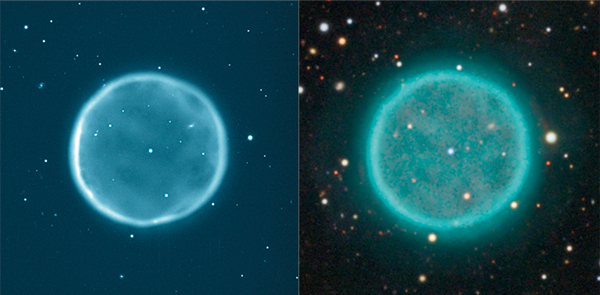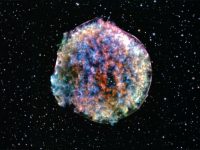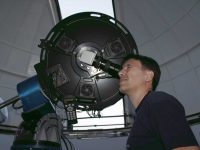
Images of the Abell 39 nebula taken two decades apart (the one on the left was captured in 1997 and the one on the right, between 2019 and 2020) / Left: NOAO/AURA/NSF / Right: OAUV, OAO, Vicent Peris
This section of Mètode is now twenty years old. It started with issue number 27, published in the year 2000. To celebrate it, I thought it would be interesting to retrieve a topic I talked about in issue 34: planetary nebulae. In that article we defined these ghostly celestial objects as the cosmic mausoleums where the remains of stars like our Sun rest when they die.
To toy with the anniversary of this section, I wanted to accompany this text with the image of the same planetary nebula taken about twenty years later. The chosen candidate was one of the most beautiful because of its almost perfectly spherical shape. Its name is Abell 39, because it is the 39th nebula in the catalog compiled by the American astronomer George Abell in 1966, which contained 86 entries of objects believed to be planetary nebulas. Not every item proved to be a planetary nebula, but most did. This nebula is located 7,000 light years from Earth in the direction of the constellation of Hercules.
«The Abell 39 nebula is located 7,000 light years from Earth in the direction of the constellation of Hercules»
The first photo (on the left) was taken in 1997 with the 3.5-meter WIYN telescope at the Kitt Peak National Observatory in Arizona, USA. A blue-green filter centred on a wavelength of 501 nanometres was used to isolate the light emitted by oxygen atoms. To obtain the second photograph (right), 111 hours of exposure time were necessary, using three filters (red, green, and blue), and two telescopes of the Aras de los Olmos Observatory of the University of Valencia: the 50 cm diameter telescope and the new large field instrument Skywalker. The observations were carried out between 2019 and 2020.
The twenty-year-old image taken in Arizona was obtained with a very large diameter telescope. That is why it has higher angular resolution. It also has greater sharpness (technically we say that it has better seeing, since the atmospheric turbulence degraded the resolution of this image to a lesser degree). We can see it in the smaller angular size of the stars or by looking at the galaxy we have circled in both images. The reduced blurriness of this image allows us to appreciate the spiral structure and even the nucleus of this galaxy, which lies 1.3 billion light-years away.
However, although the American 3.5-meter telescope captures much more light than the University of Valencia’s half-meter telescope, the exposure time used in the latter and the use of the Skywalker telescope to study faint nebular objects (with low surface brightness) makes the second image much more interesting. For example, on the 1997 photograph it was estimated that the nebula had a diameter of 5.2 light years, considering the brightest edge as the limit, which would have a width of 0.34 light years. At the same time, a weaker halo was seen around the nebula, extending the diameter of the nebula to 6.5 light years. The image obtained in Aras de los Olmos, thanks to the use of filters that highlight the contrast of the diffuse nebulae, shows that the extension of the halo is much greater, reaching 9.7 light years.
The second photograph is also superior to the first in the number of weak objects that can be seen around Abell 39 and even within it. Some of them could be stars from our galaxy located in that region of the sky, but most of them are other very remote galaxies that we see as red spots (the red shift gives them that shade). They are detected thanks to the use of a filter that lets only the longest wavelength radiation pass through. There are dozens in the image, many of them grouped in clusters and demonstrating the power of this combination of telescopes to detect low brightness objects. Astronomers say the second image is deeper.




